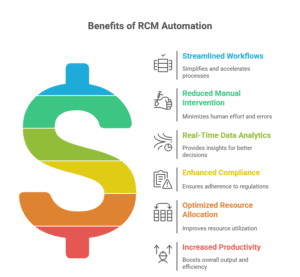In an era defined by technological transformation, Revenue Cycle Management (RCM) automation has emerged as a promising solution to the financial challenges hospitals face. By leveraging artificial intelligence, robotic process automation (RPA), and machine learning, RCM automation seeks to streamline billing processes, reduce administrative overhead, and improve cash flow. But can it truly solve all billing problems for hospitals? The answer is more nuanced than a simple yes or no.
Understanding RCM Automation
RCM automation refers to the use of advanced technologies to manage the end-to-end revenue cycle—from patient registration and insurance verification to claims submission and payment posting. Key functions typically include:
Automated eligibility and benefits verification
Claims scrubbing and coding assistance
Electronic claim submission
Denial management and appeals automation
Patient balance follow-ups and payment reminders
These systems are often integrated into hospital Electronic Health Record (EHR) platforms or operated through specialized RCM software vendors.
Benefits of RCM Automation

Error Reduction and Compliance
Automation minimizes human error, especially in data entry and coding, which significantly reduces claim rejections and denials. This also supports compliance with ever-evolving payer and regulatory requirements.Operational Efficiency
Routine, repetitive tasks like eligibility checks or appointment reminders can be performed instantly and accurately, freeing up staff for more strategic work.Faster Reimbursements
Claims processed through automated systems are usually submitted faster and with fewer errors, leading to quicker payments from insurers.Enhanced Patient Experience
Transparent billing, automated payment options, and proactive communication can enhance patient satisfaction and reduce confusion about financial responsibility.
Limitations and Challenges
Despite its transformative potential, RCM automation does not offer a one-size-fits-all solution for every billing issue:
Complex Claims and Prior Authorizations
Certain insurance plans and treatment types still require nuanced, manual interventions—especially for high-cost procedures that need detailed prior authorizations.Human Judgment and Exceptions
Automation struggles with cases requiring clinical context or interpretation, such as justifying medical necessity during appeals.Data Silos and Integration Gaps
Many hospitals use fragmented systems. If the RCM platform cannot integrate smoothly with EHRs, labs, and payer portals, automation becomes inefficient or error-prone.Staff Training and Change Management
New technologies require skilled staff to implement and manage them. Resistance to change, lack of training, or improper system configuration can create more problems than they solve.Cost and ROI Concerns
While automation reduces costs over time, initial implementation can be expensive. Smaller hospitals with limited IT budgets may find it challenging to justify the investment.
Realistic Expectations: A Hybrid Model
RCM automation is not a silver bullet—but it is a powerful tool when used correctly. The future of hospital billing lies in a hybrid approach: blending automation with skilled human oversight. Key billing functions can be automated for efficiency, while more complex or sensitive tasks should remain under human control.
Hospitals should also approach RCM automation as an ongoing strategy, not a one-time fix. Continuous monitoring, feedback loops, and adaptation to changing payer rules are essential to maximize the benefits of automation.
What Did We Learn?
RCM automation holds immense potential to solve many—but not all—billing problems hospitals face. It is best viewed as a catalyst for improvement, not a cure-all. Success lies in strategic implementation, integration, and a commitment to blending technology with human expertise. When done right, hospitals can expect fewer denials, faster reimbursements, and a better patient financial experience—hallmarks of a well-oiled revenue cycle.
What People Are Asking?
1. Can RCM automation eliminate billing errors completely?
No, but it significantly reduces errors by automating data entry, coding, and claim submission.
2. Is RCM automation suitable for all hospitals?
Yes, but scalability and cost may vary—larger systems benefit more, while smaller hospitals must assess ROI carefully.
3. Does automation replace billing staff?
No, it complements staff by handling repetitive tasks, allowing them to focus on complex or exception-based cases.
4. Can RCM automation handle prior authorizations?
Partially. Some aspects can be automated, but many cases still require manual oversight due to payer variability.
5. How fast is the ROI on RCM automation?
Most hospitals see improvements within 6–12 months, depending on implementation quality and integration depth.
Disclaimer
For informational purposes only; not applicable to specific situations.
For tailored support and professional services,
Please contact Staffingly, Inc. at (800) 489-5877
Email : support@staffingly.com.
About This Blog : This Blog is brought to you by Staffingly, Inc., a trusted name in healthcare outsourcing. The team of skilled healthcare specialists and content creators is dedicated to improving the quality and efficiency of healthcare services. The team passionate about sharing knowledge through insightful articles, blogs, and other educational resources.
 Book a Demo to Build Your Team Today!
Book a Demo to Build Your Team Today!


 Read Case Studies
Read Case Studies 


 Virtual Medical Assistants
Virtual Medical Assistants



